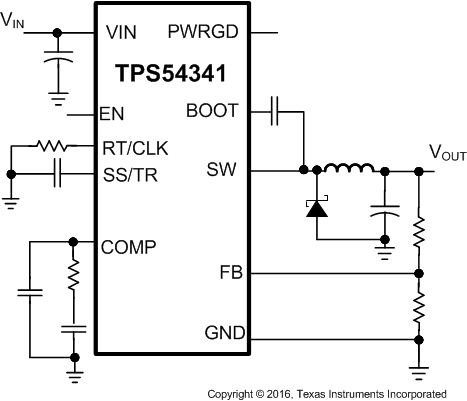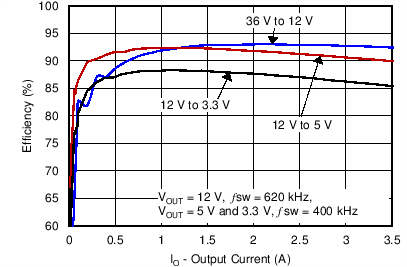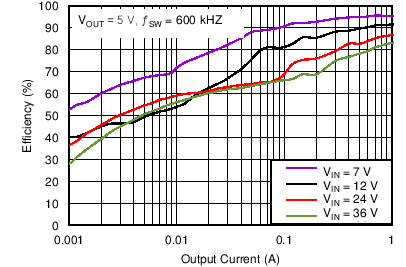-
TPS54341 4.5-V to 42-V Input, 3.5-A Step-Down DC-DC Converter With Soft-Start And Eco-Mode™
- 1 Features
- 2 Applications
- 3 Description
- 4 Revision History
- 5 Pin Configuration and Functions
- 6 Specifications
-
7 Detailed Description
- 7.1 Overview
- 7.2 Functional Block Diagram
- 7.3
Feature Description
- 7.3.1 Fixed Frequency PWM Control
- 7.3.2 Slope Compensation Output Current
- 7.3.3 Low Dropout Operation and Bootstrap Voltage (BOOT)
- 7.3.4 Error Amplifier
- 7.3.5 Adjusting the Output Voltage
- 7.3.6 Enable and Adjusting Undervoltage Lockout
- 7.3.7 Soft-Start/Tracking Pin (SS/TR)
- 7.3.8 Sequencing
- 7.3.9 Constant Switching Frequency and Timing Resistor (RT/CLK Pin)
- 7.3.10 Accurate Current Limit Operation and Maximum Switching Frequency
- 7.3.11 Synchronization to RT/CLK Pin
- 7.3.12 Power Good (PWRGD Pin)
- 7.3.13 Overvoltage Protection
- 7.3.14 Thermal Shutdown
- 7.3.15 Small-Signal Model for Loop Response
- 7.3.16 Simple Small-Signal Model for Peak-Current-Mode Control
- 7.3.17 Small Signal Model for Frequency Compensation
- 7.4 Device Functional Modes
-
8 Application and Implementation
- 8.1 Application Information
- 8.2
Typical Application
- 8.2.1 Design Requirements
- 8.2.2
Detailed Design Procedure
- 8.2.2.1 Selecting the Switching Frequency
- 8.2.2.2 Output Inductor Selection (LO)
- 8.2.2.3 Output Capacitor
- 8.2.2.4 Catch Diode
- 8.2.2.5 Input Capacitor
- 8.2.2.6 Slow-Start Capacitor
- 8.2.2.7 Bootstrap Capacitor Selection
- 8.2.2.8 Undervoltage Lockout Set Point
- 8.2.2.9 Output Voltage and Feedback Resistors Selection
- 8.2.2.10 Compensation
- 8.2.2.11 Discontinuous Conduction Mode and Eco-mode Boundary
- 8.2.2.12 Estimated Circuit Area
- 8.2.2.13 Power Dissipation Estimate
- 8.2.3 Application Curves
- 9 Power Supply Recommendations
- 10Layout
- 11Device and Documentation Support
- 12Mechanical, Packaging, and Orderable Information
- IMPORTANT NOTICE
Package Options
Mechanical Data (Package|Pins)
- DPR|10
Thermal pad, mechanical data (Package|Pins)
Orderable Information
TPS54341 4.5-V to 42-V Input, 3.5-A Step-Down DC-DC Converter With Soft-Start And Eco-Mode™
1 Features
- High Efficiency at Light Loads with Pulse Skipping Eco-mode™
- 87-mΩ High-Side MOSFET
- 152-μA Operating Quiescent Current and
2-μA Shutdown Current - 100-kHz to 2.5-MHz Adjustable Switching Frequency
- Synchronizes to External Clock
- Low Dropout at Light Loads with Integrated BOOT Recharge FET
- Adjustable UVLO Voltage and Hysteresis
- UV and OV Power-Good Output
- Adjustable Soft-Start and Sequencing
- 0.8-V 1% Internal Voltage Reference
- 10-Pin WSON with Thermal Pad Package
- –40°C to 150°C TJ Operating Range
- Supported by WEBENCH® Software Tool
2 Applications
- Industrial Automation and Motor Control
- Vehicle Accessories: GPS and Entertainment (see Creating GSM/GRPS Power Supply from TPS54260, SLVA412)
- USB-Dedicated Charging Ports and Battery Chargers (see Creating a Universal Car Charger for USB devices From the TPS54240 and TPS2511, SLVA464)
- 12-V and 24-V Industrial, Automotive and Communications Power Systems
3 Description
The TPS54341 device is a 42-V, 3.5-A step-down regulator with an integrated high-side MOSFET. The device survives load-dump pulses up to 45 V per ISO 7637. Current mode control provides simple external compensation and flexible component selection. A low-ripple pulse-skip mode reduces the no-load supply current to 152 μA. Shutdown supply current is reduced to 2 μA when the enable pin is pulled low.
Undervoltage lockout is internally set at 4.3 V but can increase using an external resistor divider at the enable pin. The output voltage startup ramp is controlled by the soft start pin that can also be configured for sequencing/tracking. An open-drain power-good signal indicates the output is within 93% to 106% of the nominal voltage.
A wide adjustable switching-frequency range allows for optimization of either efficiency or external component size. Cycle-by-cycle current limit, frequency foldback and thermal shutdown protects internal and external components during an overload condition.
The TPS54341 device is available in a 10-pin 4-mm × 4-mm WSON package.
Device Information(1)
| PART NUMBER | PACKAGE | BODY SIZE (NOM) |
|---|---|---|
| TPS54341 | WSON (10) | 4.00 mm × 4.00 mm |
- For all available packages, see the orderable addendum at the end of the data sheet.
Simplified Schematic

Efficiency vs Load Current

4 Revision History
Changes from * Revision (November 2013) to A Revision
- Added ESD Ratings table, Feature Description section, Device Functional Modes, Application and Implementation section, Power Supply Recommendations section, Layout section, Device and Documentation Support section, and Mechanical, Packaging, and Orderable Information sectionGo
5 Pin Configuration and Functions

Pin Functions
| PIN | I/O | DESCRIPTION | |
|---|---|---|---|
| NAME | NO | ||
| BOOT | 1 | O | A bootstrap capacitor is required between BOOT and SW. If the voltage on this capacitor is below the minimum required to operate the high-side MOSFET, the gate drive switches off until the capacitor refreshes. |
| COMP | 7 | O | Error amplifier output and input to the output switch current (PWM) comparator. Connect frequency compensation components to this pin. |
| EN | 3 | I | Enable pin, with internal pullup current source. Pull below 1.2 V to disable. Float to enable. Adjust the input undervoltage lockout with two resistors. See Enable and Adjusting Undervoltage Lockout for more information. |
| FB | 6 | I | Inverting input of the transconductance (gm) error amplifier. |
| GND | 8 | — | Ground |
| PWRGD | 10 | O | Power Good is an open drain output that asserts low if the output voltage is out of regulation due to thermal shutdown, dropout, over-voltage or EN shut down |
| RT/CLK | 5 | I | Resistor Timing and External Clock. An internal amplifier holds this pin at a fixed voltage when using an external resistor to ground to set the switching frequency. If the pin is pulled above the PLL upper threshold, a mode change occurs and the pin becomes a synchronization input. The internal amplifier is disabled and the pin is a high-impedance clock input to the internal PLL. If clocking edges stop, the internal amplifier re-enables and the operating mode returns to resistor frequency programming. |
| SS/TR | 4 | I | Soft-start and tracking. An external capacitor connected to this pin sets the output rise time. Because the voltage on this pin overrides the internal reference, SS/TR can be used for tracking and sequencing. |
| SW | 9 | I | The source of the internal high-side power MOSFET and switching node of the converter. |
| Thermal Pad | — | — | The GND pin must be electrically connected to the exposed pad on the printed circuit board for proper operation. |
| VIN | 2 | I | Input supply voltage with 4.5-V to 42-V operating range. |
6 Specifications
6.1 Absolute Maximum Ratings
over operating free-air temperature range (unless otherwise noted)(1)| MIN | MAX | UNIT | ||
|---|---|---|---|---|
| Input voltage | VIN | –0.3 | 45 | V |
| EN | –0.3 | 8.4 | ||
| BOOT | 53 | |||
| FB | –0.3 | 3 | ||
| COMP | –0.3 | 3 | ||
| PWRGD | –0.3 | 6 | ||
| SS/TR | –0.3 | 3 | ||
| RT/CLK | –0.3 | 3.6 | ||
| Output voltage | BOOT-SW | 8 | V | |
| SW | –0.6 | 45 | ||
| SW, transient (10 ns) | –2 | 45 | ||
| Operating junction temperature, TJ | –40 | 150 | °C | |
| Storage temperature, Tstg | –65 | 150 | °C | |
6.2 ESD Ratings
| VALUE | UNIT | |||
|---|---|---|---|---|
| V(ESD) | Electrostatic discharge | Human-body model (HBM), per ANSI/ESDA/JEDEC JS-001(1) | ±2000 | V |
| Charged-device model (CDM), per JEDEC specification JESD22-C101(2) | ±500 | |||
6.3 Recommended Operating Conditions
over operating free-air temperature range (unless otherwise noted)| MIN | MAX | UNIT | ||
|---|---|---|---|---|
| VIN | Supply input voltage | 4.5 | 42 | V |
| VO | Output voltage | 0.8 | 41.1 | V |
| IO | Output current | 0 | 3.5 | A |
| TJ | Junction Temperature | –40 | 150 | °C |
6.4 Thermal Information
| THERMAL METRIC(1)(2) | TPS54341 | UNIT | |
|---|---|---|---|
| DPR (WSON) | |||
| 10 PINS | |||
| RθJA | Junction-to-ambient thermal resistance | 35.1 | °C/W |
| RθJC(top) | Junction-to-case (top) thermal resistance | 34.1 | °C/W |
| RθJB | Junction-to-board thermal resistance | 12.3 | °C/W |
| ψJT | Junction-to-top characterization parameter | 0.3 | °C/W |
| ψJB | Junction-to-board characterization parameter | 12.5 | °C/W |
| RθJC(bot) | Junction-to-case (bottom) thermal resistance | 2.2 | °C/W |
6.5 Electrical Characteristics
TJ = –40°C to 150°C, VIN = 4.5 V to 42 V (unless otherwise noted)| PARAMETER | TEST CONDITIONS | MIN | TYP | MAX | UNIT | ||
|---|---|---|---|---|---|---|---|
| SUPPLY VOLTAGE (VIN PIN) | |||||||
| Operating input voltage | 4.5 | 42 | V | ||||
| Internal undervoltage lockout threshold | Rising | 4.1 | 4.3 | 4.48 | V | ||
| Internal undervoltage lockout threshold hysteresis | 325 | mV | |||||
| Shutdown supply current | EN = 0 V, 25°C, 4.5 V ≤ VIN ≤ 42 V | 2.25 | 4.5 | μA | |||
| Operating: nonswitching supply current | FB = 0.9 V, TA = 25°C | 152 | 200 | ||||
| ENABLE AND UVLO (EN PIN) | |||||||
| Enable threshold voltage | No voltage hysteresis, rising and falling | 1.1 | 1.2 | 1.3 | V | ||
| Input current | Enable threshold = 50 mV | –4.6 | μA | ||||
| Enable threshold = –50 mV | –0.58 | –1.2 | –1.8 | ||||
| Hysteresis current | –2.2 | –3.4 | –4.5 | μA | |||
| Enable to COMP active | VIN = 12 V, TA = 25°C | 540 | µs | ||||
| VOLTAGE REFERENCE | |||||||
| Voltage reference | 0.792 | 0.8 | 0.808 | V | |||
| HIGH-SIDE MOSFET | |||||||
| On-resistance | VIN = 12 V, BOOT-SW = 6 V | 87 | 185 | mΩ | |||
| ERROR AMPLIFIER | |||||||
| Input current | 50 | nA | |||||
| Error amplifier transconductance (gm) | –2 μA < ICOMP < 2 μA, VCOMP = 1 V | 350 | μMhos | ||||
| Error amplifier transconductance (gm) during soft-start |
–2 μA < ICOMP < 2 μA, VCOMP = 1 V, VFB = 0.4 V | 77 | μMhos | ||||
| Error amplifier DC gain | VFB = 0.8 V | 10000 | V/V | ||||
| Min unity gain bandwidth | 2500 | kHz | |||||
| Error amplifier source and sink | V(COMP) = 1 V, 100-mV overdrive | ±30 | μA | ||||
| COMP to SW current transconductance | 12 | A/V | |||||
| CURRENT LIMIT | |||||||
| Current limit threshold | All VIN and temperatures, open loop(1) | 4.5 | 5.5 | 6.8 | A | ||
| All temperatures, VIN = 12 V, open loop(1) | 4.5 | 5.5 | 6.3 | ||||
| VIN = 12 V, TA = 25°C, open loop(1) | 5.2 | 5.5 | 5.9 | ||||
| Current limit threshold delay | 60 | ns | |||||
| THERMAL SHUTDOWN | |||||||
| Thermal shutdown | 176 | °C | |||||
| Thermal shutdown hysteresis | 12 | °C | |||||
| TIMING RESISTOR AND EXTERNAL CLOCK (RT/CLK PIN) | |||||||
| Switching frequency range using RT mode | 100 | 2500 | kHz | ||||
| ƒSW | Switching frequency | RT = 200 kΩ | 450 | 500 | 550 | kHz | |
| Switching frequency range using CLK mode | 160 | 2300 | kHz | ||||
| Minimum CLK input pulse width | 15 | ns | |||||
| RT/CLK high threshold | 1.55 | 2 | V | ||||
| RT/CLK low threshold | 0.5 | 1.2 | V | ||||
| RT/CLK falling edge to SW rising edge delay | Measured at 500 kHz with RT resistor in series | 55 | ns | ||||
| PLL lock in time | Measured at 500 kHz | 78 | μs | ||||
| SOFT START AND TRACKING (SS/TR PIN) | |||||||
| Charge current | VSS/TR = 0.4 V | 1.7 | µA | ||||
| SS/TR-to-FB matching | VSS/TR = 0.4 V | 42 | mV | ||||
| SS/TR-to-reference crossover | 98% nominal | 1.16 | V | ||||
| SS/TR discharge current (overload) | FB = 0 V, VSS/TR = 0.4 V | 354 | µA | ||||
| SS/TR discharge voltage | FB = 0 V | 54 | mV | ||||
| POWER GOOD (PWRGD PIN) | |||||||
| FB threshold for PWRGD low | FB falling | 90% | |||||
| FB threshold for PWRGD high | FB rising | 93% | |||||
| FB threshold for PWRGD low | FB rising | 108% | |||||
| FB threshold for PWRGD high | FB falling | 106% | |||||
| Hysteresis | FB falling | 2.5% | |||||
| Output high leakage | VPWRGD = 5.5 V, TA = 25°C | 10 | nA | ||||
| On resistance | IPWRGD = 3 mA, VFB < 0.79 V | 45 | Ω | ||||
| Minimum VIN for defined output | VPWRGD < 0.5 V, IPWRGD = 100 µA | 0.9 | 2 | V | |||
6.6 Typical Characteristics
 Figure 1. On Resistance vs Junction Temperature
Figure 1. On Resistance vs Junction Temperature

vs Junction Temperature

vs Junction Temperature
 Figure 7. Switching Frequency vs
Figure 7. Switching Frequency vsRT/CLK Resistance High Frequency Range
 Figure 9. EA Transconductance During Soft-Start
Figure 9. EA Transconductance During Soft-Startvs Junction Temperature
 Figure 11. EN Pin Current vs Junction Temperature
Figure 11. EN Pin Current vs Junction Temperature
 Figure 13. EN Pin Current Hysteresis
Figure 13. EN Pin Current Hysteresisvs Junction Temperature
 Figure 15. Shutdown Supply Current
Figure 15. Shutdown Supply Currentvs Junction Temperature
 Figure 17. VIN Supply Current
Figure 17. VIN Supply Currentvs Junction Temperature
 Figure 19. BOOT-SW UVLO
Figure 19. BOOT-SW UVLOvs Junction Temperature
 Figure 21. PWRGD On Resistance
Figure 21. PWRGD On Resistancevs Junction Temperature
 Figure 23. SS/TR to FB Offset vs FB
Figure 23. SS/TR to FB Offset vs FB
 Figure 25. 5-V Start and Stop Voltage (see Low Dropout Operation and Bootstrap Voltage (BOOT))
Figure 25. 5-V Start and Stop Voltage (see Low Dropout Operation and Bootstrap Voltage (BOOT))
 Figure 2. Voltage Reference
Figure 2. Voltage Referencevs Junction Temperature
 Figure 4. Switch Current Limit vs Input Voltage
Figure 4. Switch Current Limit vs Input Voltage
 Figure 6. Switching Frequency vs
Figure 6. Switching Frequency vsRT/CLK Resistance Low Frequency Range
 Figure 8. EA Transconductance
Figure 8. EA Transconductancevs Junction Temperature
 Figure 10. EN Pin Voltage vs Junction Temperature
Figure 10. EN Pin Voltage vs Junction Temperature
 Figure 12. EN Pin Current vs Junction Temperature
Figure 12. EN Pin Current vs Junction Temperature
 Figure 14. Switching Frequency vs FB
Figure 14. Switching Frequency vs FB

vs Input Voltage (VIN)

 Figure 20. Input Voltage UVLO
Figure 20. Input Voltage UVLOvs Junction Temperature
 Figure 22. PWRGD Threshold
Figure 22. PWRGD Thresholdvs Junction Temperature
 Figure 24. SS/TR to FB Offset vs Temperature
Figure 24. SS/TR to FB Offset vs Temperature